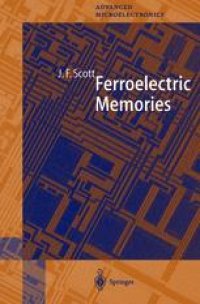
Ebook: Ferroelectric Memories
Author: Professor James F. Scott (auth.)
- Tags: Metallic Materials, Electronics and Microelectronics Instrumentation, Memory Structures
- Series: Springer Series in Advanced Microelectronics 3
- Year: 2000
- Publisher: Springer-Verlag Berlin Heidelberg
- Edition: 1
- Language: English
- pdf
Ferroelectric memories have changed in 10 short years from academic curiosities of the university research labs to commercial devices in large-scale production. This is the first text on ferroelectric memories that is not just an edited collection of papers by different authors. Intended for applied physicists, electrical engineers, materials scientists and ceramists, it includes ferroelectric fundamentals, especially for thin films, circuit diagrams and processsing chapters, but emphazises device physics. Breakdown mechanisms, switching kinetics and leakage current mechanisms have lengthly chapters devoted to them. The book will be welcomed by research scientists in industry and government laboratories and in universities. It also contains 76 problems for students, making it particularly useful as a textbook for fourth-year undergraduate or first-year graduate students.
Ferroelectric memories have changed in 10 short years from academic curiosities of the university research labs to commercial devices in large-scale production. This is the first text on ferroelectric memories that is not just an edited collection of papers by different authors. Intended for applied physicists, electrical engineers, materials scientists and ceramists, it includes ferroelectric fundamentals, especially for thin films, circuit diagrams and processsing chapters, but emphazises device physics. Breakdown mechanisms, switching kinetics and leakage current mechanisms have lengthly chapters devoted to them. The book will be welcomed by research scientists in industry and government laboratories and in universities. It also contains 76 problems for students, making it particularly useful as a textbook for fourth-year undergraduate or first-year graduate students.
Ferroelectric memories have changed in 10 short years from academic curiosities of the university research labs to commercial devices in large-scale production. This is the first text on ferroelectric memories that is not just an edited collection of papers by different authors. Intended for applied physicists, electrical engineers, materials scientists and ceramists, it includes ferroelectric fundamentals, especially for thin films, circuit diagrams and processsing chapters, but emphazises device physics. Breakdown mechanisms, switching kinetics and leakage current mechanisms have lengthly chapters devoted to them. The book will be welcomed by research scientists in industry and government laboratories and in universities. It also contains 76 problems for students, making it particularly useful as a textbook for fourth-year undergraduate or first-year graduate students.
Content:
Front Matter....Pages I-XVI
Introduction....Pages 1-22
Basic Properties of RAMs (Random Access Memories)....Pages 23-51
Electrical Breakdown (DRAMs and NV-RAMs)....Pages 53-77
Leakage Currents....Pages 79-94
Capacitance—Voltage Data: C(V)....Pages 95-120
Switching Kinetics....Pages 121-132
Charge Injection and Fatigue....Pages 133-143
Frequency Dependence....Pages 145-147
Phase Sequences in Processing....Pages 149-152
SBT-Family Aurivillius-Phase Layer Structures....Pages 153-164
Deposition and Processing....Pages 165-174
Nondestructive Read-Out Devices....Pages 175-178
Ferroelectrics-on-Superconductor Devices: Phased-Array Radar and 10–100 GHz Devices....Pages 179-184
Wafer Bonding....Pages 185-187
Electron-Emission and Flat-Panel Displays....Pages 189-190
Optical Devices....Pages 191-192
Nanophase Devices....Pages 193-208
Drawbacks and Disadvantages....Pages 209-215
Exercises....Pages 217-223
Back Matter....Pages 225-248
Ferroelectric memories have changed in 10 short years from academic curiosities of the university research labs to commercial devices in large-scale production. This is the first text on ferroelectric memories that is not just an edited collection of papers by different authors. Intended for applied physicists, electrical engineers, materials scientists and ceramists, it includes ferroelectric fundamentals, especially for thin films, circuit diagrams and processsing chapters, but emphazises device physics. Breakdown mechanisms, switching kinetics and leakage current mechanisms have lengthly chapters devoted to them. The book will be welcomed by research scientists in industry and government laboratories and in universities. It also contains 76 problems for students, making it particularly useful as a textbook for fourth-year undergraduate or first-year graduate students.
Content:
Front Matter....Pages I-XVI
Introduction....Pages 1-22
Basic Properties of RAMs (Random Access Memories)....Pages 23-51
Electrical Breakdown (DRAMs and NV-RAMs)....Pages 53-77
Leakage Currents....Pages 79-94
Capacitance—Voltage Data: C(V)....Pages 95-120
Switching Kinetics....Pages 121-132
Charge Injection and Fatigue....Pages 133-143
Frequency Dependence....Pages 145-147
Phase Sequences in Processing....Pages 149-152
SBT-Family Aurivillius-Phase Layer Structures....Pages 153-164
Deposition and Processing....Pages 165-174
Nondestructive Read-Out Devices....Pages 175-178
Ferroelectrics-on-Superconductor Devices: Phased-Array Radar and 10–100 GHz Devices....Pages 179-184
Wafer Bonding....Pages 185-187
Electron-Emission and Flat-Panel Displays....Pages 189-190
Optical Devices....Pages 191-192
Nanophase Devices....Pages 193-208
Drawbacks and Disadvantages....Pages 209-215
Exercises....Pages 217-223
Back Matter....Pages 225-248
....